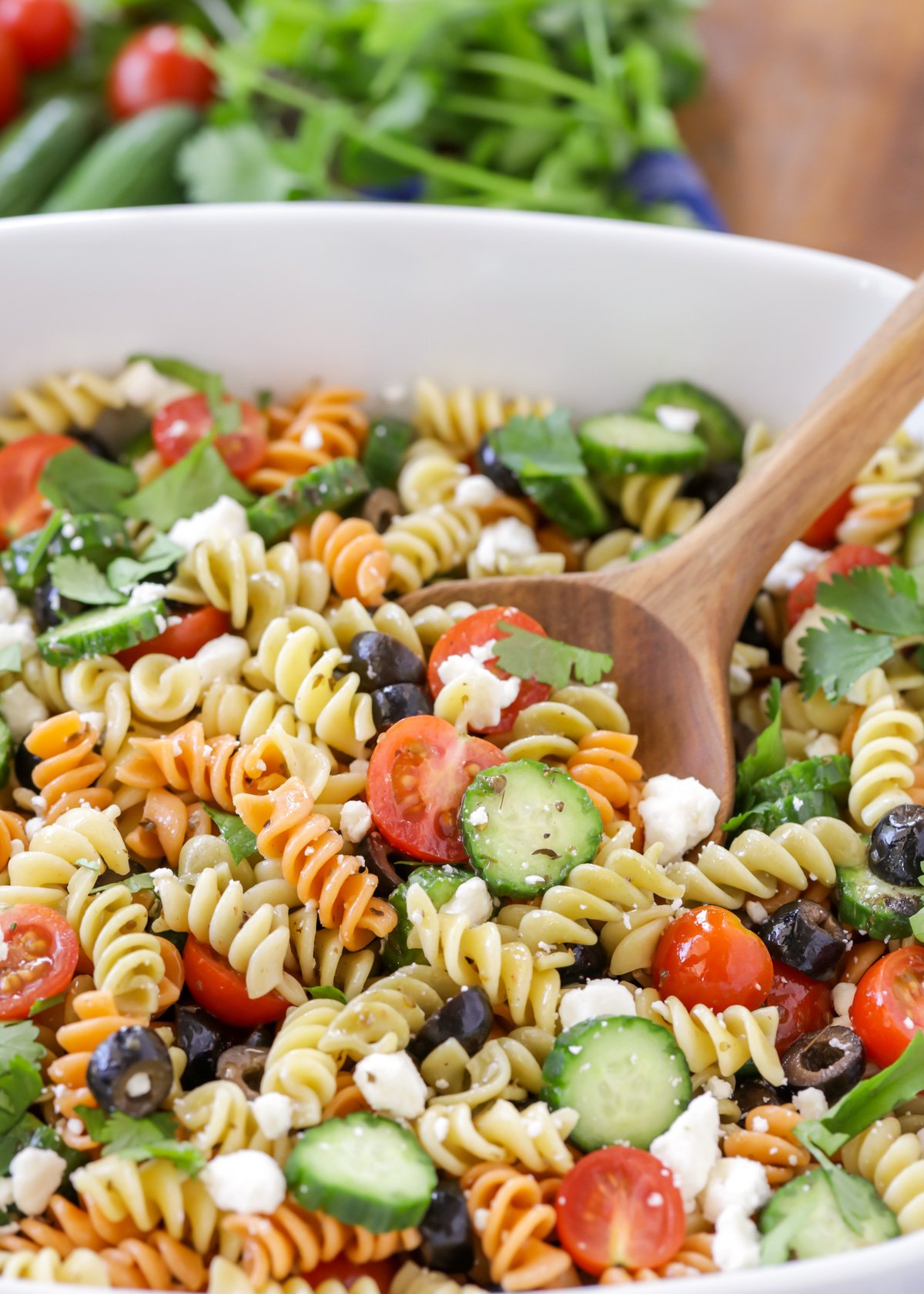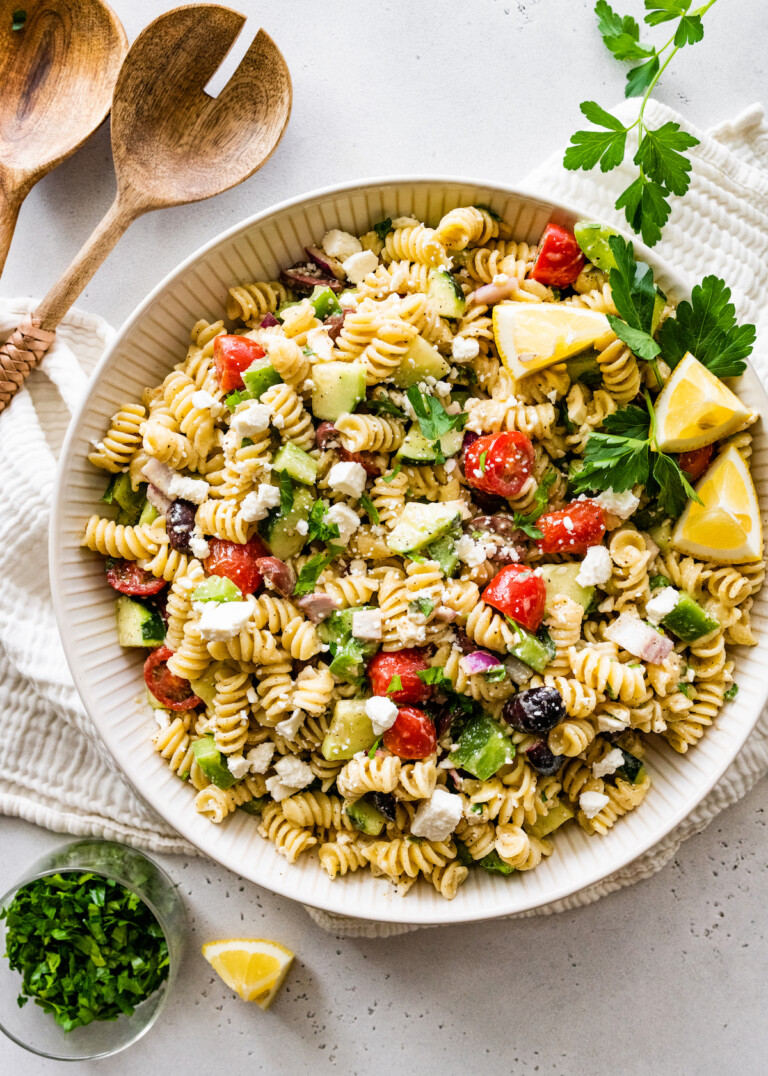A Taste of the Aegean: Exploring the Vibrant World of Greek Pasta Salad

Greek pasta salad, far from a simple side dish, is a vibrant tapestry woven from the sun-drenched flavors of the Mediterranean. It’s a dish that transcends mere culinary function; it’s a celebration of fresh ingredients, a testament to the simplicity of great cooking, and a portal to the idyllic landscapes of Greece. This seemingly straightforward salad boasts a complex profile, a harmonious blend of salty feta, briny olives, crisp vegetables, and a tangy, herbaceous dressing that dances on the palate. But beyond its deliciousness lies a rich history and a versatility that allows for endless variations, making it a perennial favorite for summer gatherings and casual meals alike.
A Culinary Journey Through History:
While pinpointing the exact origin of Greek pasta salad is impossible, its evolution mirrors the historical exchange of culinary traditions in the Mediterranean. Pasta, a staple of Italian cuisine, found its way into Greek cooking, adapting seamlessly to the region’s unique flavor profiles. The use of olives, feta cheese, and an abundance of fresh herbs, all hallmarks of Greek cuisine, transformed the humble pasta salad into something distinctly Grecian.
The salad’s popularity likely surged in the latter half of the 20th century, coinciding with the rise of tourism in Greece and the increased global appreciation for Mediterranean cuisine. It became a staple at tavernas and seaside restaurants, quickly gaining recognition as a quintessential representation of Greek summer fare. Its transportability and ability to be enjoyed at room temperature made it ideal for picnics, beach outings, and informal gatherings, further contributing to its widespread appeal.
The Essential Ingredients: A Symphony of Flavors:
The beauty of Greek pasta salad lies in its simplicity and the quality of its ingredients. Each component plays a crucial role in creating the overall flavor profile, and using fresh, high-quality ingredients is paramount to achieving the best results.
-
Pasta: While any small pasta shape works, rotini, farfalle (bowties), or ditalini are popular choices due to their ability to hold the dressing well. The pasta should be cooked al dente – firm to the bite – to avoid a mushy texture. Overcooked pasta will absorb too much of the dressing, resulting in a soggy salad.
-
Feta Cheese: The salty, tangy bite of feta is indispensable to the authentic Greek pasta salad experience. Crumbled feta adds a creamy texture and a sharp contrast to the other ingredients. Opt for high-quality feta made from sheep’s or goat’s milk for the best flavor.
-
Olives: Kalamata olives, with their deep purple color and intensely briny flavor, are a classic choice. However, other olives, such as Castelvetrano or green olives, can also be incorporated to add variety. The olives contribute a salty, slightly bitter element that balances the richness of the feta and the sweetness of the vegetables.

-
Vegetables: The vegetable selection is where creativity can truly shine. Classic choices include ripe tomatoes, crisp cucumbers, red onion, and bell peppers. These vegetables provide a refreshing crunch and a burst of sweetness that complements the other flavors. Some recipes also include artichoke hearts, capers, or even fresh herbs like oregano or dill.

Dressing: The dressing is the heart and soul of the Greek pasta salad. A simple vinaigrette, typically made with olive oil, red wine vinegar, lemon juice, oregano, and garlic, is the foundation. The ratio of oil to vinegar can be adjusted to taste, creating a balance between tanginess and richness. Adding a touch of honey or Dijon mustard can enhance the complexity of the dressing.

Beyond the Basics: Exploring Variations and Creative Twists:
While the classic Greek pasta salad is a masterpiece in itself, the beauty of this dish lies in its adaptability. Feel free to experiment with different ingredients and flavors to create your own unique version.
-
Adding Protein: Grilled chicken, shrimp, or chickpeas can be added for a heartier salad, transforming it into a complete meal. The protein adds another layer of flavor and texture, making it a satisfying option for lunch or dinner.
-
Herbs and Spices: Fresh herbs such as oregano, basil, dill, and parsley can elevate the flavor profile. A pinch of red pepper flakes can add a touch of heat for those who enjoy a spicier kick.
-
Citrus Zest: Lemon or orange zest adds a bright, citrusy note that complements the other flavors beautifully.
-
Different Types of Cheese: While feta is traditional, other cheeses like halloumi or even a crumbled goat cheese can be incorporated for a slightly different taste experience.
-
Seasonal Vegetables: Utilize seasonal vegetables to create a constantly evolving and flavorful salad. In the summer, juicy tomatoes and crisp cucumbers are perfect, while in the fall, roasted butternut squash or zucchini can add a delightful twist.
Mastering the Art of Greek Pasta Salad: Tips and Techniques:
-
Cook the pasta al dente: This prevents the pasta from becoming mushy and ensures a pleasant texture.
-
Don’t overdress the salad: Add the dressing gradually, tasting as you go. Overdressing will result in a soggy salad.
-
Let the flavors meld: Allow the salad to sit for at least 30 minutes before serving to allow the flavors to develop and blend together. The flavors will deepen and intensify as the salad rests.
-
Use fresh, high-quality ingredients: The quality of the ingredients directly impacts the overall taste of the salad. Fresh vegetables and good quality feta cheese are essential.
-
Adjust the seasoning to your liking: Taste the salad and adjust the seasoning as needed. Add more salt, pepper, lemon juice, or herbs to achieve your preferred flavor balance.
Serving Suggestions and Pairing Ideas:
Greek pasta salad is incredibly versatile and can be enjoyed in a variety of settings. It’s perfect as a side dish for grilled meats, fish, or poultry. It also makes a delightful lunch or light dinner, especially when served with crusty bread or a simple green salad. For a more substantial meal, consider adding grilled chicken or chickpeas.
The salad pairs well with crisp white wines such as Assyrtiko or Sauvignon Blanc, or a refreshing rosé. Its bright, zesty flavors also complement the herbaceous notes of many Mediterranean herbs and spices.
Conclusion:
Greek pasta salad is more than just a recipe; it’s a culinary experience that transports you to the sun-kissed shores of Greece. Its vibrant colors, fresh flavors, and simple elegance make it a beloved dish across the globe. Whether you’re a seasoned cook or a culinary novice, this salad is a testament to the power of fresh ingredients and the magic of simple preparations. So, gather your ingredients, embrace the sun-drenched flavors, and embark on a culinary journey to the Aegean with a bowl of this delightful and versatile dish. Experiment, adapt, and create your own unique version – the possibilities are as endless as the Aegean Sea itself.

Video tentang A Taste of the Aegean: Exploring the Vibrant World of Greek Pasta Salad
Penutup
Therefore, we hope this article has provided valuable insights on A Taste of the Aegean: Exploring the Vibrant World of Greek Pasta Salad. We hope you found this article informative and helpful. See you in our next article!

